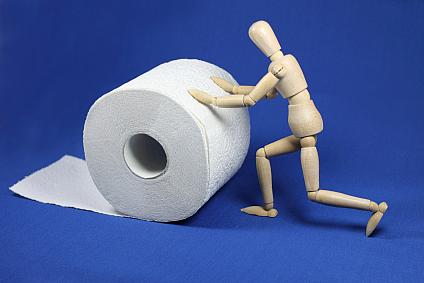Complete Health Reporting: Avoid Extremes to Avoid Disease Mongering

Driving a motorcycle into the back of a parked car. Taunting a rhinoceros. Hurrying to the bathroom to relieve yourself.
You may not know it, but all three are ways in which you could end up breaking your bones. Or at least that’s what the consumer health website WebMD tells us in its guide to overactive bladders. It’s another example of the ways that health writers can engage in disease mongering.
Exaggerate the impact a real illness has on someone’s quality of life.
Here’s what WebMD says:
Even without incontinence, overactive bladder can make it hard to do the things you enjoy. The need to drop everything and race to the bathroom can disrupt your life. And if you leak, even if it's only a little bit, it can be embarrassing. Overactive bladder can cause other problems too. Hurrying to the bathroom can lead to falls and broken bones. Overactive bladder can also cause sleeping problems, depression, and urinary tract infections.
Note the “can cause.” If you take that to its logical conclusion, an overactive bladder can cause death. In fact, it would be interesting to see if the number of people who broke bones while rushing to the loo is lower than the number of people who – because of the urge to urinate – died by falling out of an open window or crashing their twin-engine plane into the side of a mountain.
What can a health writer do about it?
1. Define the population at risk. Bladder problems can have a quality of life impact, no doubt. And incontinence can make matters worse. Liz Scherer at Flashfree has written about both, always taking care to define who is affected. She wrote recently, for example, about evidence linking estrogen to incontinence:
Indeed, results from the infamous Women’s Health Initiative study demonstrated that women who were randomized to combination hormone therapy or estrogen only were at increased risk for worsening urinary incontinence symptoms or for developing urinary incontinence after only one year of use. However, like other data from this study, questions have been raised with regard to the findings, namely that they are not applicable to the general population. And yet, it is critical to learn if using hormone therapy increases urinary incontinence risk; these conditions significantly affect quality of life and at their severest, limit physical and social activities, limit intimacy and other relationships, limit work productivity and affect overall wellbeing. Rather than generalize, however, it’s important to take a close look at ethnically diverse populations of women in the community and tease out if there are any specific factors related to estrogen use that increase incontinence risk.
2. Isolate the condition’s triggers. When drugmakers started ramping up the marketing of pills to treat overactive bladders – you know the ones that make you want to run to the bathroom after the first 10 seconds – Jamie Kopf Hirsh at Consumer Reports wrote about her own habit of frequently urinating. She asked her doctor about the drugs, and her doctor asked her a few questions before concluding that she probably didn’t need a drug:
She said the amount I was urinating made sense given how much liquid I drank and the fact that, given my petite stature and family history of constant pit stops, chances were I had a pretty small bladder. She could prescribe one of the drugs, she said, which work by powerfully suppressing the urge to urinate. But I probably didn’t need it. ... There are people who need drugs for urinary symptoms—indeed, our own Best Buy Drugs project offers research-based recommendations on the best medications approved to treat overactive bladder, including some you may have seen advertised. But plenty of people don’t need medication. Or, as in my case, in the risk-benefit ratio that should form the basis of any medical treatment decision, it just doesn’t make sense to take on the potential side effects—and they can be harsh—to realize a benefit that, for me, would amount to a few less minutes spent waiting in line for the Starbucks bathroom every week.
3. Focus on the mean, not the extremes. This Complete Health Reporting series started as a way of explaining the criteria that I and other reviewers at HealthNewsReview.org use when critiquing stories. Gary Schwitzer, the site’s publisher, asks a series of questions to decide whether a health writer is disease mongering, including:
Have you exaggerated the human consequences of a condition? Are you using interviews with “worst-case” scenario patients, holding such patients up as examples as if they were representative of all with this condition?
In other words, just because you track down a patient who broke his nose while running to the bathroom, don’t feature him as the lead of your story.
Do you have your own favorite example of disease mongering or how to avoid it? Drop a comment below or send it to askantidote@gmail.com. You also can reach me via Twitter @wheisel.
Related Posts:
Complete Health Reporting: Steer Clear of Disease-Mongering Quicksand
Complete Health Reporting: Does Baldness Really Need a Cure?
